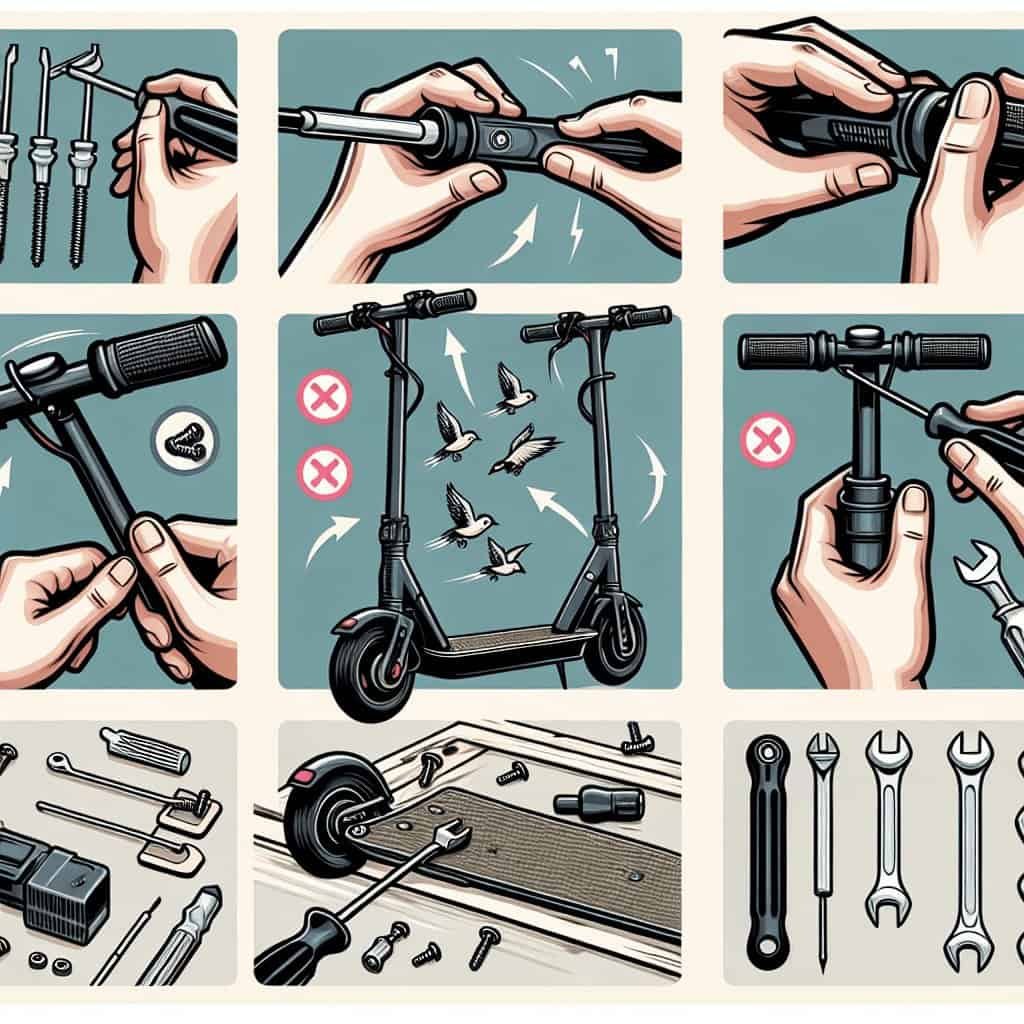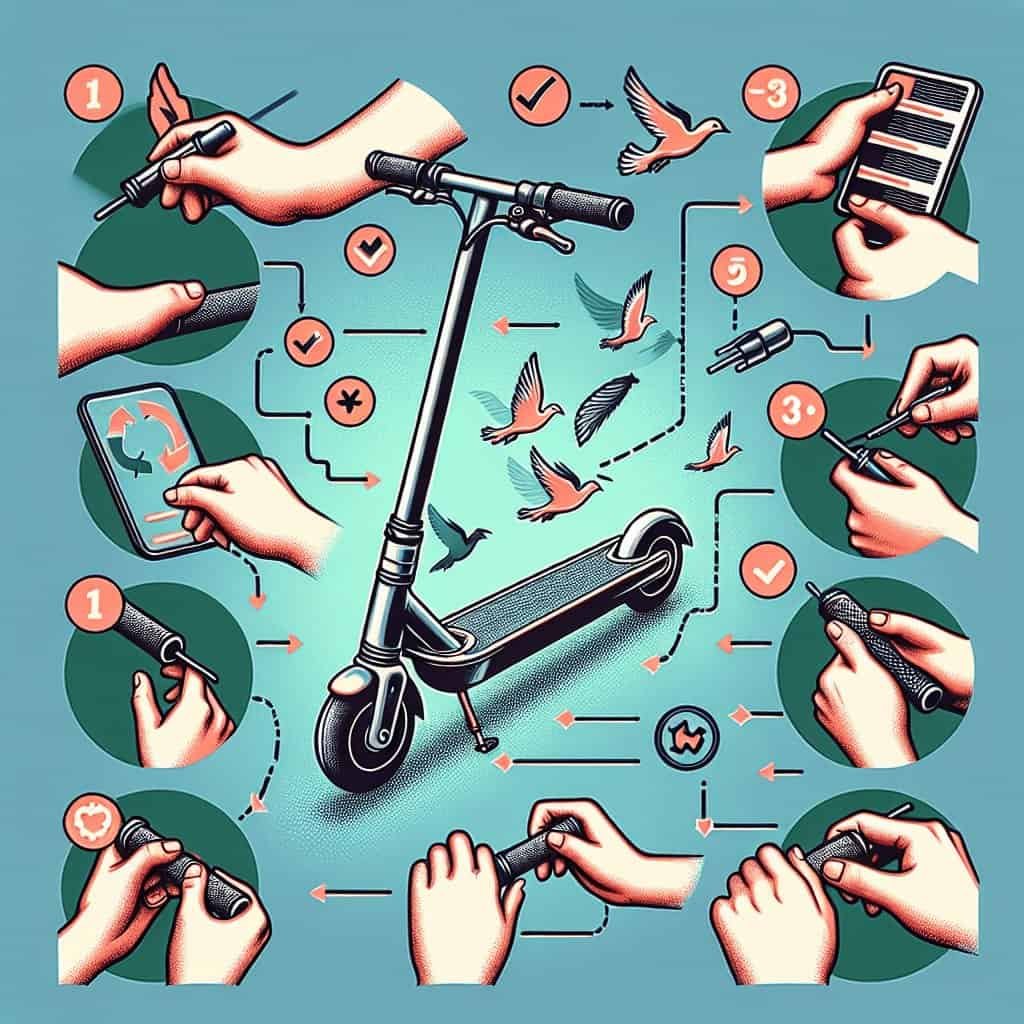If you’re a proud owner of an electric scooter, you may have noticed that over time, the handlebar grips can become worn out or lose their grip. Not to worry though, checking and replacing these grips is a simple task that you can easily do yourself. In this article, we’ll guide you through the steps to ensure your electric scooter’s handlebar grips are in top condition, providing you with a safe and comfortable ride every time. So let’s get started and give your scooter the handlebar grips it deserves.

Inspecting the Handlebar Grips
When it comes to maintaining your electric scooter, checking the handlebar grips should be a top priority. The handlebar grips not only provide comfort and stability during your rides but also play a crucial role in ensuring your safety. Therefore, it is important to regularly inspect the handlebar grips for signs of wear and tear, cracks or tears, grip firmness, secure attachment, and excessive dirt or grime.
Checking for Signs of Wear and Tear
Begin the inspection by carefully examining the handlebar grips for any visible signs of wear and tear. Over time, constant use and exposure to various weather conditions can cause the grips to deteriorate. Look for any noticeable thinning of the material, particularly in areas where your hand typically rests. If you notice any uneven wear or fraying, it may be time to consider replacing the grips.
Examining for Cracks or Tears
Next, check the handlebar grips for any cracks or tears. These can develop over time due to the repetitive pressure and stress applied to the grips while riding. Cracks and tears not only compromise the grip’s effectiveness but also increase the risk of injury. Run your fingers along the entire length of the grip, paying close attention to any areas that feel rough or uneven. If you notice any cracks or tears, it is necessary to replace the grips promptly.
Evaluating the Grip’s Firmness
The firmness of the grip is crucial for maintaining control and stability while riding your electric scooter. Gently squeeze the grip with your hand and assess its firmness. If the grip feels excessively soft or squishy, it may be a sign of internal damage or wear. On the other hand, if the grip is overly firm or rigid, it can cause discomfort and numbness in your hands during longer rides. Ideally, the grip should have a slight amount of give while still providing a secure and stable hold.
Ensuring the Grip is Securely Attached
A loose or poorly attached handlebar grip can greatly affect your ability to control the electric scooter. Check that the grip is securely fastened to the handlebar, with no play or movement. Gently twist the grip in both directions to check for any looseness. If you feel excessive movement or notice gaps between the grip and the handlebar, it is crucial to tighten or replace the grip before riding.
Looking for Excessive Dirt or Grime
Lastly, inspect the handlebar grips for any excessive dirt or grime buildup. Dirt and grime can accumulate over time, especially if you frequently ride your electric scooter in dusty or muddy environments. A buildup of dirt and grime not only affects the grip’s effectiveness but also makes it unhygienic and potentially slippery. Wipe down the grips thoroughly with a damp cloth or use mild soap and water to clean them. Ensure they are completely dry before continuing with your inspection or replacing the grips.
Removing the Old Handlebar Grips
Once you have completed the inspection and determined that the handlebar grips need replacement, it’s time to remove the old grips. Follow these steps to ensure a smooth and efficient removal process.
Determining the Grip Type
Before removing the old handlebar grips, it is important to determine their type. Handlebar grips can be either slip-on or lock-on grips. Slip-on grips are typically made of rubber or foam and slide onto the handlebar. Lock-on grips, on the other hand, have an inner sleeve that clamps onto the handlebar, providing a more secure attachment. Knowing the grip type will help you choose the appropriate removal technique.
Loosening the Grip with Compressed Air
If you have slip-on grips, one effective method for removal is using compressed air. Locate the end of the grip and insert the nozzle of a compressed air canister underneath its edge. Slowly release a burst of air, which should create a gap between the grip and the handlebar. Once a gap is formed, you can carefully slide the grip off the handlebar.
Using a Screwdriver to Pry the Grip
If you are unable to remove the grips using compressed air, another option is to use a screwdriver. Insert the flat head of a screwdriver between the grip and the handlebar, near the end of the grip. Gently pry the grip away from the handlebar, gradually working your way around the entire circumference of the grip. Exercise caution to avoid scratching or damaging the handlebar during the process.
Applying a Mixture of Dish Soap and Water
For stubborn slip-on grips that are difficult to remove, you can create a mixture of dish soap and water to lubricate the grip. Dilute a small amount of dish soap in water and apply the solution to the grip, either by spraying or using a sponge. The lubrication provided by the soap and water mixture will make it easier to slide the grip off the handlebar. Again, be mindful of any potential damage to the handlebar during the removal process.
Applying Solvent for a Stubborn Grip
If all else fails and the grip still refuses to budge, you may need to resort to a solvent. Apply a small amount of an appropriate solvent, such as rubbing alcohol or WD-40, to the grip and allow it to penetrate for a few minutes. The solvent should loosen the grip’s adhesive properties, making it easier to slide off the handlebar. Use caution when working with solvents, as they can be flammable and may require proper ventilation.

Installing the New Handlebar Grips
After successfully removing the old handlebar grips, it’s time to install the new ones. Follow these steps to ensure a proper and secure installation.
Choosing the Suitable Replacement Grips
When selecting replacement grips, it is essential to choose ones that are compatible with your electric scooter model and handlebar size. Measure the diameter of your handlebar to determine the appropriate grip size. Consider the material and design of the grip as well, ensuring it meets your comfort and style preferences. Additionally, opt for grips that offer good grip and cushioning for a comfortable riding experience.
Applying Lubricant to the Handlebar
Before installing the new handlebar grips, applying a small amount of lubricant to the handlebar can aid in the installation process. Use a lubricant specifically designed for rubber or foam surfaces. Apply a thin, even layer of the lubricant to the handlebar, ensuring full coverage but avoiding excessive amounts that may lead to slippage.
Aligning the Grip with the Handlebar
Begin the installation process by aligning the grip with the handlebar. Ensure that the grip is facing the right direction, with any logos or patterns positioned appropriately. Position the grip in line with the handlebar, leaving a small gap at the end of the handlebar to prevent the grip from sliding off during use.
Sliding the Grip onto the Handlebar
With the grip properly aligned, gently slide it onto the handlebar. Apply a consistent amount of pressure, ensuring the grip moves smoothly and evenly onto the handlebar. Avoid twisting or rotating the grip during installation, as this can cause uneven wear and lead to discomfort while riding. Continue sliding the grip until it reaches the desired position, making sure it is snug and feels secure.
Tightening the Grip
To ensure a secure and long-lasting installation, it is important to tighten the grip firmly onto the handlebar. If you have lock-on grips, follow the specific instructions provided by the manufacturer to properly tighten the clamps. For slip-on grips, firmly tap the end of the grip against a solid surface, such as the ground or a workbench, to push it further onto the handlebar. This will help secure the grip in place.
Alternative Methods for Installing Grips
While the above steps outline the traditional installation process for handlebar grips, there are a few alternative methods that some riders find effective. These methods can be particularly useful if you are having difficulty installing the grips using the conventional techniques. Here are some alternative methods you can try:
Using Hair Spray
Believe it or not, hair spray can be used as a temporary adhesive to help install handlebar grips. Thoroughly clean and dry the handlebar, then spray a small amount of hair spray onto the handlebar and inside the grip. Quickly slide the grip onto the handlebar before the hair spray dries. The sticky residue left by the hair spray will provide additional grip and help keep the grip in place.
Applying Heat
Applying heat to the grip can make it more pliable and easier to slide onto the handlebar. Use a hairdryer or soak the grips in warm water for a few minutes to warm them up. Once the grips are sufficiently heated, quickly slide them onto the handlebar. As the grips cool, they will tighten their grip on the handlebar.
Freezing the Grips
A non-traditional method involves freezing the grips before installation. Place the grips in a freezer for a few hours until they become cold and stiff. Once chilled, quickly slide the grips onto the handlebar. As the grips return to room temperature, they will expand slightly, providing a tight and secure fit on the handlebar.
Using Compressed Air
Similar to the method of using compressed air to remove old grips, you can also use it to install new grips. Apply a burst of compressed air to the grip, creating a small gap between the grip and the handlebar. While maintaining the gap with the compressed air, slide the grip onto the handlebar. Once the grip is in place, release the compressed air to allow the grip to secure itself to the handlebar.
Using an Air Compressor
If you have access to an air compressor, you can use it to facilitate the installation of handlebar grips. Connect a nozzle to the air compressor and insert it into the open end of the grip. Gradually release compressed air into the grip, causing it to inflate and expand. This expansion allows the grip to slide easily onto the handlebar. Once the grip is in place, release the air pressure to let the grip secure itself.

Replacing Handlebar Grips on Different Types of Electric Scooters
Electric scooters come in various designs and configurations, each with its unique handlebar grip installation process. Here are some guidelines for replacing handlebar grips on different types of electric scooters:
Foldable Electric Scooters
For foldable electric scooters, the handlebar grips are often slip-on grips. Follow the general instructions mentioned earlier for removing and installing slip-on grips. However, pay attention to any additional features or components of the folding mechanism that may require extra care during the installation process. Ensure the grips are securely attached but still allow for smooth folding and unfolding of the scooter.
Three-Wheel Electric Scooters
Three-wheel electric scooters typically have handlebars with either slip-on or lock-on grips. Determine the grip type and choose the appropriate removal and installation techniques accordingly. For lock-on grips, refer to the specific instructions provided by the manufacturer. Take extra care during the installation to align the grips properly since the stability and control of three-wheel scooters heavily rely on the handlebars.
Off-Road Electric Scooters
Off-road electric scooters often demand a more secure grip for improved control and stability. When replacing handlebar grips on off-road scooters, consider choosing grips that are specifically designed for rugged terrains. Look for grips with enhanced grip patterns or cushioning features to provide maximum comfort and control during off-road rides. Follow the general installation process mentioned earlier, ensuring the grips are tightly secured to withstand the demanding conditions.
Self-Balancing Electric Scooters
Self-balancing electric scooters, also known as hoverboards, typically have built-in grips or handlebar covers that cannot be easily replaced. If the original grips are worn out or damaged, it is recommended to consult the manufacturer or a professional technician for guidance on replacement options. Attempting to replace the grips on self-balancing scooters without proper knowledge or expertise may result in further damage to the scooter.
Electric Scooters with Twist Throttles
Electric scooters with twist throttles typically have handlebar grips that include built-in throttle mechanisms. When replacing these grips, it is crucial to select grips that are specifically compatible with the twist throttle design. Ensure the replacement grips have the appropriate cutouts or grooves to accommodate the throttle mechanism. Follow the general installation process mentioned earlier, paying special attention to aligning the throttle properly while installing the new grips.
Maintenance Tips for Prolonging Handlebar Grips’ Lifespan
Proper maintenance of your handlebar grips is essential for prolonging their lifespan and enjoying a comfortable and safe riding experience. Here are some maintenance tips to keep in mind:
Regular Cleaning
Regularly clean your handlebar grips to remove dirt, sweat, and debris that can accumulate over time. Use a mild soap and water solution or a designated grip cleaner to thoroughly clean the grips. Avoid using harsh chemicals or abrasive cleaners, as they can damage the grips’ material. After cleaning, ensure the grips are fully dry before riding.
Avoiding Exposure to Direct Sunlight
Extended exposure to direct sunlight can cause handlebar grips to fade, become brittle, and deteriorate more quickly. Whenever possible, store your electric scooter in a shaded area or use a cover to protect it from direct sunlight. If you frequently park your scooter outdoors, consider investing in grip covers or handlebar tape to provide additional protection.
Using Grip Covers or Gloves
Using grip covers or gloves can provide an extra layer of protection for your handlebar grips. Grip covers made of silicone, foam, or neoprene can prevent direct contact between your hands and the grips, reducing wear and tear. Additionally, gloves specifically designed for scooter riding can offer cushioning, insulation, and grip enhancement, protecting both your hands and the grips.
Storing the Scooter Properly
Properly storing your electric scooter can go a long way in preserving the integrity of the handlebar grips. When not in use, store your scooter in a clean and dry environment, preferably indoors. Avoid leaving the scooter exposed to harsh weather conditions or extreme temperatures, as these can accelerate wear and tear on the grips and other components.
Checking for Loose Grips
Regularly check the tightness of your handlebar grips to ensure they remain securely attached. Over time, vibrations and constant use can cause the grips to become loose. Gently twist the grips in both directions to check for any movement or play. If you notice any looseness, tighten the grips accordingly following the specific instructions provided by the grip manufacturer.

Common Problems with Handlebar Grips
Handlebar grips can experience various issues due to normal wear and tear or improper maintenance. Here are some common problems associated with handlebar grips:
Slipping Grips
Slipping grips occur when the grips loosen or slide on the handlebar during riding. This can greatly affect your control and stability, creating a potentially hazardous situation. If you notice your grips slipping, tighten them immediately according to the specific instructions provided by the grip manufacturer. If the slipping continues, consider replacing the grips entirely for a more secure fit.
Worn-out Grips
Worn-out grips typically exhibit visible signs of wear, such as thinning material, loss of grip patterns, or uneven texture. When the grips become worn out, they provide less cushioning, deteriorated grip, and decreased comfort. Replace worn-out grips promptly to maintain optimal control and riding experience.
Torn or Damaged Grips
Torn or damaged grips not only compromise your grip and comfort but can also lead to injury. Thoroughly inspect your grips for any tears, punctures, or other damage. If you notice any such damage, replace the grips as soon as possible to ensure your safety.
Grips Coming Loose
Grips that constantly come loose can be frustrating and unsafe. Loose grips not only affect your control and stability but can also increase the risk of accidents. If your grips frequently come loose despite tightening, consider using grip adhesives or alternative installation methods to achieve a more secure attachment.
Incompatible Grips
Choosing incompatible grips for your electric scooter can lead to a range of issues. Grips that are the wrong size, shape, or design for your handlebar can be difficult to install or may not provide a secure fit. Always ensure compatibility when selecting replacement grips, following the manufacturer’s recommendations or consulting a professional if needed.
Potential Risks of Faulty Handlebar Grips
Using faulty or worn-out handlebar grips can have serious consequences for your safety and riding experience. Here are some potential risks associated with using faulty handlebar grips:
Decreased Control and Handling
Faulty grips, such as ones that are slippery, loose, or worn out, can significantly decrease your ability to maintain control over your electric scooter. This can compromise your handling of the scooter, leading to an increased risk of accidents or loss of control.
Loss of Grip in Wet Conditions
Wet or rainy conditions can significantly reduce the grip provided by handlebar grips. If your grips are already worn out or lacking proper traction, the risk of losing grip and control increases even further. This can make riding in wet conditions particularly hazardous.
Increased Vibration and Discomfort
Worn-out or damaged grips may no longer effectively absorb vibrations, resulting in increased discomfort during rides. The excessive vibration transmitted through the handlebars can cause numbness, tingling sensations, or even pain in your hands and arms. Prolonged exposure to such vibrations can result in long-term discomfort or potential injuries.
Compromised Safety and Stability
Handlebar grips play a crucial role in maintaining the safety and stability of your electric scooter. Faulty or improper grips can make it difficult to steer, control speed, or maneuver effectively, putting both you and others at risk. It is essential to address any grip-related issues promptly to ensure a safe riding experience.
Difficulty Operating the Scooter
When the handlebar grips are not in optimal condition, operating your electric scooter can become more challenging and potentially dangerous. Grips that are too firm or too soft, loose, or improperly positioned can make it uncomfortable or even impossible to control the scooter accurately. This can negatively impact your overall riding experience and potentially lead to accidents.

Frequently Asked Questions (FAQs)
Here are some commonly asked questions regarding handlebar grips on electric scooters:
How often should I replace handlebar grips on an electric scooter?
The frequency of replacing handlebar grips depends on various factors, including the quality of the grips, frequency of use, and environmental conditions. As a general guideline, it is recommended to inspect the grips regularly and replace them at the first signs of wear, tear, damage, or decreased effectiveness. Proactively replacing the grips before they become excessively worn or compromised is the best way to ensure your safety and riding comfort.
Can I use non-electric scooter grips on my electric scooter?
While it is possible to use non-electric scooter grips on an electric scooter, it is important to ensure compatibility. Electric scooters often have specific handlebar designs, sizes, or grip attachment mechanisms that may require specific grips. Always check the manufacturer’s recommendations or consult with a professional to ensure you choose compatible grips for your electric scooter.
Are there different sizes of handlebar grips available?
Yes, handlebar grips come in different sizes to accommodate the varying diameters of electric scooter handlebars. It is crucial to measure the diameter of your handlebar accurately and choose grips with a matching size. Using incorrectly sized grips can lead to a loose or insecure fit, compromising your control and safety.
Can I reuse the old grips after removing them?
In most cases, it is not recommended to reuse old grips once they have been removed. Handlebar grips are subject to wear, tear, and stretching during use, which can affect their performance and safety. Additionally, removing grips often damages them in the process. It is best to invest in new grips to ensure optimal performance, comfort, and safety.
Do I need any specialized tools for replacing handlebar grips?
Replacing handlebar grips typically does not require specialized tools. The removal and installation processes can typically be completed using basic household tools such as screwdrivers and lubricants. However, certain grip types, such as lock-on grips, may require specific tools or accessories to ensure proper installation. Always refer to the manufacturer’s instructions or consult with a professional if you are unsure about the specific requirements for your electric scooter’s grips.
Conclusion
Maintaining and replacing handlebar grips on your electric scooter not only ensures your comfort and control but also plays a vital role in your safety. By regularly inspecting and evaluating the condition of the grips, you can identify and address any issues before they escalate. Follow the appropriate techniques and methods for removing and installing handlebar grips, ensuring a secure and reliable attachment. Choose grips that are compatible with your electric scooter model and handlebar size, and consider additional maintenance practices to extend their lifespan. By doing so, you can enjoy a comfortable, safe, and enjoyable riding experience on your electric scooter for years to come.

